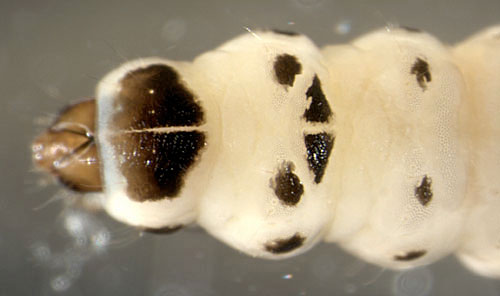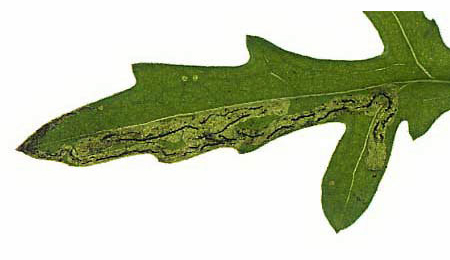|
||||||
|
ANTHEMIS. Chamomiles [Asteraceae] |
|
Five species of Anthemis are recorded in Britain. These include the native Corn Chamomile (A. arvensis) and Stinking Chamomile (A. cotula), and the introduced Yellow Chamomile (A. tinctoria) and Sicilian Chamomile (A. punctata).The BSBI provide a downloadable plant crib for Anthemis. Seven British miners are recorded on Anthemis. The agromyzid Napomyza lateralis feeds in the stems of Anthemis, Bidens, Calendula, Dimorphotheca, Matricaria, and Senecio in Britain, although it has also been found in the inflorescence of Matricaria. |
Key for the identification of the known mines of British |
1a > Stem-miner: A narrow, inconspicuous stem mine. Pupation at the end of the mine (Spencer, 1976: 64). Fine, upper- or lower-surface corridor, ending in a thick vein. From there the mine extends finally to the rind of the stem. There also the pupation takes place, usually not far from the root collar. Mines in the stem rind often are conspicuous through a red discoloration. |
|
| Ophiomyia curvipalpis (Zetterstedt, 1848) [Diptera: Agromyzidae]. |
1b > Leaf-miner and case-bearer: Larva mines leaves. On Eupatorium the case is extended at the anal end by adding silk and widened by cutting a ventral gusset. On Inula the case is firstly extended by adding rings of leaf-cuticle at the oral end, before reverting to the method used when on Eupatorium. The full-grown case is 10 mm long. A slender tubular silken case, about 10 mm long, straw coloured, three valved. Mouth angle about 30°. |
 Coleophora folicularis larva, dorsal Image: © Willem Ellis (Bladmineerders van Europa) |
|
Coleophora follicularis (Vallot, 1802) [Lepidoptera: Coleophoridae]. |
1c > Leaf-miner, but not a case-bearer |
2a > Leaf-miner: A distinctive mine primarily above mid-rib, with irregular short lateral offshoots into leaf blade. Pupation external (Spencer, 1972: 51 (fig. 172), 55; Spencer, 1976: 270, 271 (fig. 486)). Branched, whitish, upper-surface corridor; main axis overlying the midrib; side branches overlying the main lateral veins. (In Campanula and Phyteuma the mine is much less branched, sometimes nothing more than a corridor on top of the midrib). Frass in rather long strings. Usually the mines begins as a long and narrow, shallow, tortuous lower-surface corridor that ends upon the midrib but otherwise is not associated with the leaf venation. Often this initial corridor is filled with callus, and then even less conspicuous. Pupation outside the mine. A linear mine on the upper surface, usually following the midrib and showing side branches along the veins. The frass is in strings. |
|
Liriomyza strigata (Meigen, 1830) [Diptera: Agromyzidae]. |
2b > Leaf-miner: Mine linear, whitish, both upper and lower surface. Pupation internal, at the end of the mine with the anterior spiracles projecting through the epidermis (Spencer, 1976: 433). Upper-surface, less often lower-surface corridor. Frass in isolated grains. Pupation within the mine, usually in a lower-surface puparial chamber. A long whitish upper surface corridor, which eventually goes lower surface. |
|
Chromatomyia
horticola (Goureau, 1851) [Diptera: Agromyzidae] |
2c > Leaf-miner: A narrow linear mine, even in the finest subdivisions of the leaves (Spencer, 1972b: 77, as matricariae ; Spencer, 1976: 478). Very fine corridor, upper- or lower-surface, even in the narrowest leaf segments. The corridor may be up to 14 cm long (Sehgal, 1971a). Generally the corridor descends towards the leaf base. Frass in pearl chains of loose grains, hardly in strings. Pupation outside the mine. Very fine corridor, upper- or lower-surface, even in the narrowest leaf segments. The corridor may be up to 14 cm long (Sehgal, 1971a). Generally the corridor descends towards the leaf base. Frass in pearl chains of loose grains, hardly in strings. Pupation outside the mine. |
|
Phytomyza pullulaZetterstedt, 1848 [Diptera: Agromyzidae]. |
2d > Leaf-miner: A short irregular linear mine with frass in more or less connected threads. |
 Mine of Liriomyza centaurea on Centaurea scabiosa Image: © Willem Ellis (Bladmineerders van Europa) |
|
Liriomyza centaureae Hering, 1927 [Diptera: Agromyzidae]. |
2e > Leaf-miner: The mine begins as a long, quite narrow corridor, usually not far from the tip of a leaf segment. Usually this corridor follows the leaf margin for some distance, but it may also run freely through the blade and may then be stongly contorted. In the end the corridor is directed towards the midrib, where an elongated blotch is formed, overlying the midrib and some of the larger lateral veins. Frass in a nearly continuous line in the initial corridor, in scattered lumps in the later part of the mine. Primary and secondary feeding lines very conspicuous when seen in transparancy. Pupation outside the mine. The mine starts as a very narrow corridor, usually close to the tip of a leaf segment and following the leaf margin. The later section of the corridor approaches the main vein, where an elongated blotch is made with long broad finger like extensions that lay over the secondary veins. In the initial corridor the frass forms an almost continuous line, in the blotch it is distributed in large scattered lumps. In fresh mines the secondary feeding lines are clearly visible. |
|
Trypeta zoe Meigen, 1826 [Diptera: Tephritidae]. |
2f > Leaf miner: The larva feeds in a leaf-mine to begin with, then later feeds externally on the leaves, shrivelling and blanching or browning them. Initially an extremely fine corridor along the leaf margin; these mines mainly in the lower leaves. Frass in a narrow central line. The larva can leave its mine and restart elsewhere. Older larvae live free, and feed by slicing open the margin of a leaf segment near its tip and eating away as much tissue as it can reach (to about one third of its body length). The result is a number of full depth blotch mines. When the larva has become too large even for this strategy, its starts to feed freely on the leaf. The larva pupates in a distinctive whitish ribbed cocoon. |
|
Bucculatrix cristatella (Zeller, 1839) [Lepidoptera: Bucculatricidae]. |
| Last updated 30-Jun-2019 Brian Pitkin | ||
